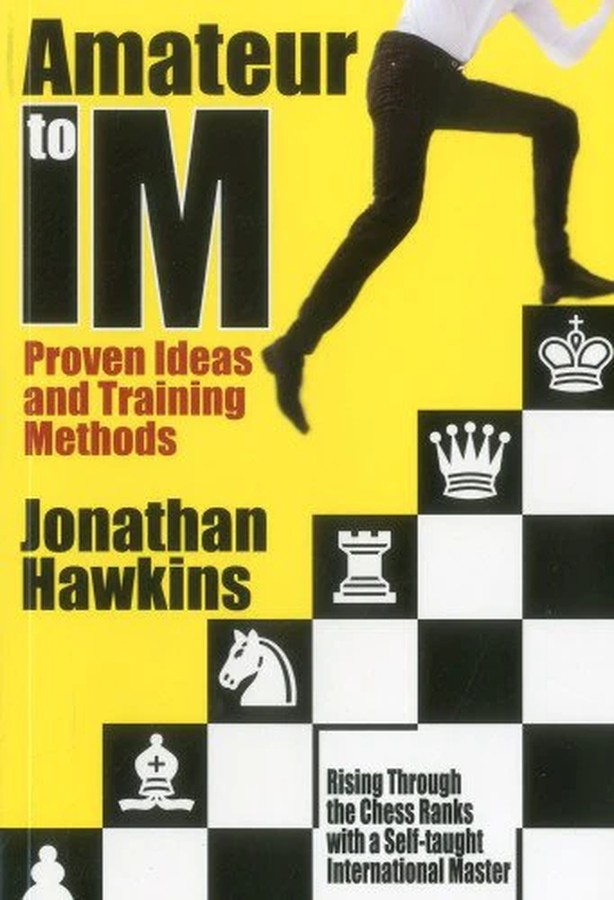| Nivå | B-D |
| Utgivelsesdato | November 2012 |
| Forfatter | |
| Pris | 305 NOK |
Amateur to IM
Proven Ideas and Training MethodsUventet viser dette seg å være en ren sluttspillbok! Forfatteren (født 1983) har en kometaktig karriere i voksen alder og forklarer her på en inspirerende og grundig måte sluttspillene som han har studert. Det er mange grunnleggende sluttspill som vi antagelig burde kunne...
IM Jonathan Hawkins har per høsten 2012 to GM-napp og FIDE-rating 2511. Så sent som i 2007 hadde han en beskjeden FIDE-rating på 2207.
Noen av partiene i boka er komplette fra åpning til og med sluttspill, men de fleste er bare sluttspillet. Gå i gang, så kommer framganen, forteller han!
Forfatterens forord
Hello, chess friends!
This is International Master Jonathan Hawkins from England. You find me just as I am finishing writing this book. I will try to keep this introduction short… We can trace the history of the book you now hold back in time eight years. Somewhere around that time there came a point when I decided I’d had enough. Being a (relatively) weak chess player wasn’t for me. I committed a large portion of my time to studying chess, which was, in hindsight, quite a bad idea since I was starting university at the time.
I always had quite a strong memory for chess. Ever since I learned the game I could recall all of my games – and the games of others – easily. So openings were my topic of study and I could memorize opening theory with no problem. I actually made some improvement in playing strength with this rather artificial method of study. At some point though, this all changed and I became addicted to studying the endgame. I filled notebook after notebook with endgame analysis. This is what led to my biggest improvement. It also felt as if my better understanding helped me to assimilate more knowledge.
Now – eight years, approximately 400 rating points and two GM norms later – I am passing on some of the endgames I studied to you. These represent literally my first steps up the chess ladder. I hope you will find the material interesting and that it will help you in some way.
Why the Endgame?
Why did I choose the endgame for the subject of this book? Why will it improve the reader’s chess? The simple answer is that I am convinced a careful study of the endgame sparked the biggest leap forward in my own game. Can it really be that the endgame is more important than other phases of the game?
I would say that it is more a question of balance than of one phase being more worthy of our study time than another. Let us sketch the portrait of a modern player to illustrate the typical imbalance:
- With the wealth of opening literature, and the ease of access to the latest Grandmaster games on computer databases, it is no great task to build up a highlevel opening repertoire. Time consuming perhaps, but the path to take is not a difficult one.
Indeed, I have listened to Grandmasters lament the unfairness of this. Gone are the days when the ‘weaker’ player can be routinely dispatched in the opening. - Combined with the knowledge of standard schemes in the middlegame – linked to their opening repertoire (which is relatively easy to attain, by playing through master games in the relevant openings) – we have painted the picture of quite a formidable foe.
All of this is perfectly reasonable, and I encourage the reader to spend time doing exactly these things.
We have, however, a clear motivation here for focusing (at least some) of our chess energy on the endgame:
- Our opponents will typically have a clear weakness in this area.
- We want to fortify our game with a strong endgame foundation; otherwise we will be throwing away many good positions (and points!). Of course, we must expect a certain amount of crossover between the phases of the game. Knowledge of endgames is useful when studying the openings; often modern opening theory is so deep that it transposes directly into endgames. All of this not new advice; in fact, most players know this already. Why then is the endgame such a neglected phase of the game?
There is no question it is more difficult to study than, say, the opening. Most endgame works, typically featuring general rules and many theoretical positions, are rather too dull to study. By the time we get the theoretical position we memorized, many years may have passed and we have forgotten the details. Computers often offer little help. I found this very evident when analyzing the opposite-colored bishop endgame Aronian-Bacrot in ‘Endgame Exploration 2’.
We are all guilty of mimicking the world’s strongest players to some degree, and it is true that they work considerably on openings. The reason is that they are already proficient in theoretical and technical endgames. Occasionally this is not the case and, as we do a few times throughout this book, we can enjoy the feeling that we know something an elite player did not!
Aims of the book
I did not intend in any way for this to be an exhaustive theoretical manual. My aim was always just to start the ball rolling and help the reader to think about chess in a different and more coherent way. Everything we learn we will try to understand to the level where it can be used in a practical game.
- I wanted to show that chess is an interesting game which is definitely not played out; there are often countless possibilities in even the most innocent looking position (take the Aronian – Bacrot game I discuss later, for example).
- I wanted to teach good principles in the endgame and (although it was not my primary goal) to show some important theoretical endgames. Some of the theoretical endgames in the book are not essential knowledge, but I saw no reason to dumb anything down if they were relevant to the analysis.
- I also wanted to spark the reader’s interest in analysis and investigation of chess positions. Always search for the truth, and never pass something by without understanding it.
The astute reader will notice that some of the examples in the book are quite recent. It is true that I updated some of the games from my original notebooks. Be assured I only did this when I felt the new example was stronger than the old.
I should say a few words about the structure of the book and how best to use it:
- It is split into two main parts. The first half is quite lightweight, and focuses on some thinking techniques, principles and some essential theoretical endgames. The second half is quite deep and involves analysis and discussion of some very specific types of endgame. There is also a short section of exercises.
- Most chapters have a ‘Theoretical Notes’ section at the end. Any theoretical endgames or particularly interesting variations which cropped up in the main lessons and required further coverage are discussed there.
When we encounter a specific theoretical position (or type of position) I would recommend playing it out several times, against a playing partner or an engine. My favorite way to do this is to play without studying the position at all. Only afterwards do I study the analysis of the position and repeat the process. In this way you will see the problems in the position really clearly, since you are already committed to thinking rather than just memorizing.
When playing over the annotated games (or game fragments) the primary goal is to retain the patterns and ideas, and the secondary goal is to use the arising positions to hone your analytical skills. Memorizing the game, move by move, is not something you need to consciously try to do. Once you understand the moves and ideas this will happen automatically. To this end I would recommend playing over the games quite rapidly in order to digest the main points. Later, upon completion of the chapter in question, you can look at the games and side variations in more detail.
OK, we will leave it there. Let’s play some chess!
Jonathan Hawkins, March 2012
| Innbundet? | Nei |
| Type | Bok |
| Språk | Engelsk |
| Antall sider | 369 |

